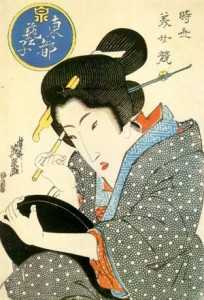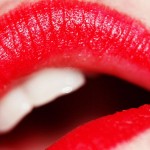 In 18th century Japan, samurai women modeled themselves after the great beauties of the day. Like courtesans and geishas, they turned their faces into artists’ canvases, concealing their skins beneath a thick white paste. Then they applied the paint–thin charcoal lines for eyebrows, delicate crimson for mouths, and a dark black tint for their teeth. All this artifice, all this feminine allure came at a steep price, however. This week, Japanese researchers revealed that high levels of lead in ancient cosmetics likely poisoned generations of samurai children.
In 18th century Japan, samurai women modeled themselves after the great beauties of the day. Like courtesans and geishas, they turned their faces into artists’ canvases, concealing their skins beneath a thick white paste. Then they applied the paint–thin charcoal lines for eyebrows, delicate crimson for mouths, and a dark black tint for their teeth. All this artifice, all this feminine allure came at a steep price, however. This week, Japanese researchers revealed that high levels of lead in ancient cosmetics likely poisoned generations of samurai children.
The Japanese team, led by Tamiji Nakashima, an anatomist at the University of Occupational and Environmental Health in Kitakyushu, Japan, became suspicious of the women’s makeup after testing skeletal remains from the Edo period ( A.D. 1603 to 1867). Skeletons from the samurai class contained surprisingly high levels of lead, far higher than that found among fishers and farmers in the lower classes. Moreover samurai women were twice as contaminated as samurai men.
Puzzled, Nakashima and his colleagues began searching for the source. Historical accounts showed that the white foundation paste so loved by samurai women contained white lead. Brushing it on to their skins and inhaling paste particles, the women slowly poisoned themselves and unwittingly passed on the contaminant to their nursing babies. As a result, some young samurai children possessed enough lead in their systems to cause severe developmental disabilities.
Could something similar happen today? Out of curiosity, I decided to check with the Campaign for Safe Cosmetics.  A coalition founded by Friends of the Earth, National Environmental Trust and a variety of women’s health groups, this consumer advocacy organization keeps a very close eye on women’s products. In August 2007, it conducted a study on lead in 33 women’s lipsticks purchased in the United States, detecting between 0.03 and 0.65 parts per million of lead in 61 percent of the products.
A coalition founded by Friends of the Earth, National Environmental Trust and a variety of women’s health groups, this consumer advocacy organization keeps a very close eye on women’s products. In August 2007, it conducted a study on lead in 33 women’s lipsticks purchased in the United States, detecting between 0.03 and 0.65 parts per million of lead in 61 percent of the products.
At first blush, that may not sound like a lot. But look at it another way: Nearly 33 percent of the lipsticks exceeded the limit of 0.1 parts per million that the U.S. Food and Drug administration has established for lead in candy. Should women be worried?
In 2009, a research team at King Faisal Specialist Hospital & Research Centre in Saudi Arabia did a follow-up study, testing for lead in 26 imported lipsticks and 8 eyeshadows. Most of the brands proved to be safe, but a few possessed levels of lead exceeding 20 parts per million and these, the team noted, “might put consumers at the risk of lead poisoning. Lead is a cumulative, and applying lead-containing cosmetics several times a day or every day, can potentially add up to significant exposure levels. Pregnant and nursing mothers are [a] vulnerable population because lead passes through the placenta and human milk and affects fetus or infant’s development.”
Then, the Saudis let loose the big cannons. “Our findings call for an immediate mandatory regular testing program to check lead and other toxic metals in lipsticks and other cosmetic products imported to Saudi Arabia in order to curtail their excess and safeguard consumer health.”
History, it seems, has a way of repeating itself.
Upper Image: print by Keisai Eisen (1790-1848)
Lower Image: courtesy of Weglet
Your second link is only to the Pubmed home page. Did you mean this article http://www.ncbi.nlm.nih.gov/pubmed/19250956 for the followup study from King Faisal Specialist Hospital & Research Centre in Saudi Arabia?
Thanks for picking this up, Lisa. Yes that is the right study!